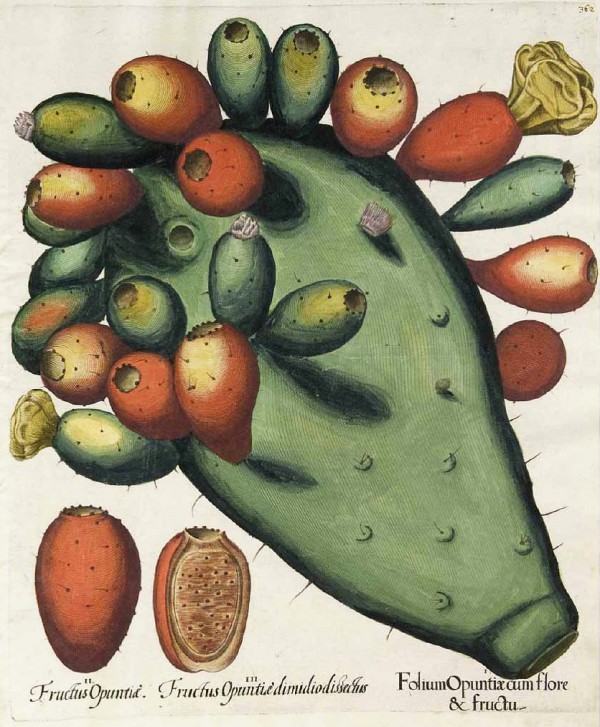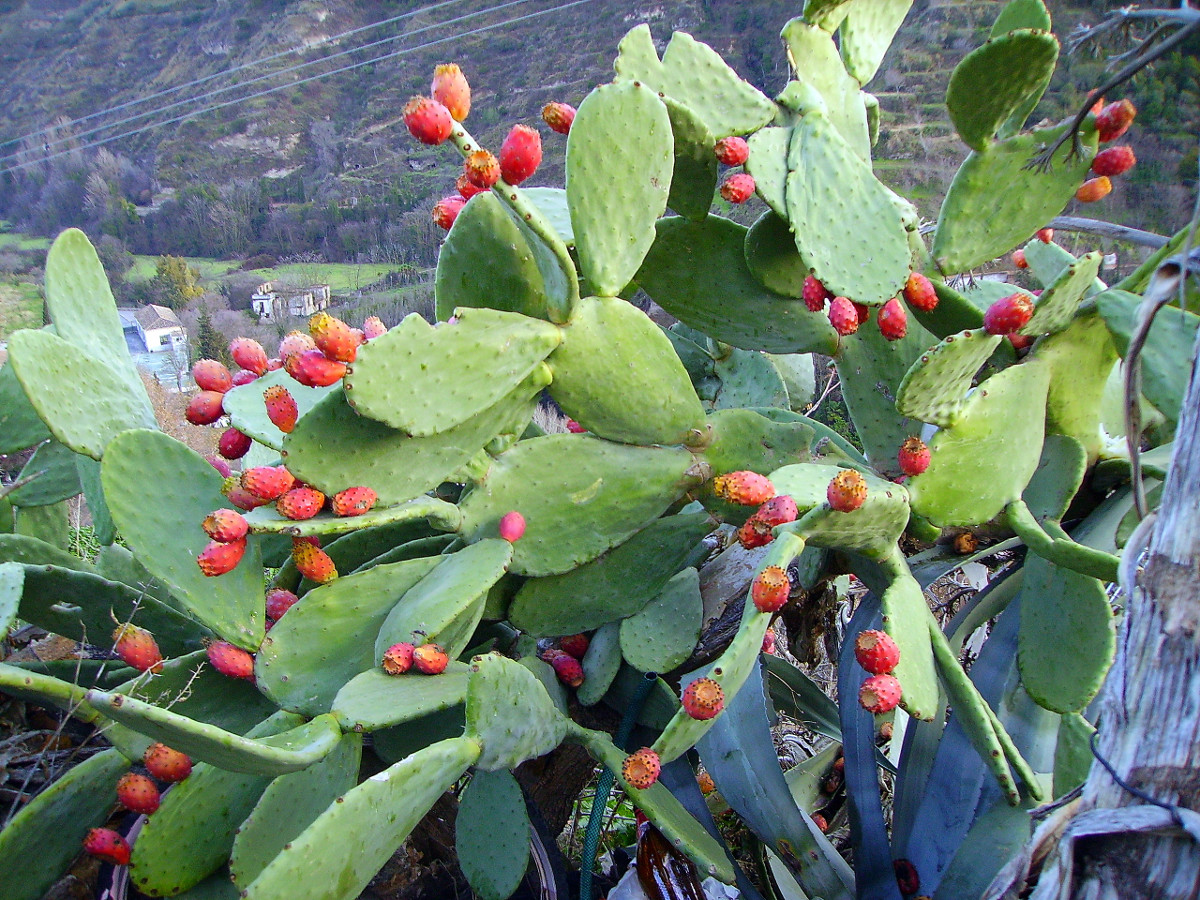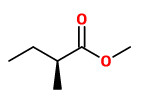Opuntia ficus-indica (L.) Mill. - syn.Cactus ficus-indica L.; Opuntia decumana (Willd.) Haw.; Opuntia gymnocarpa F. A. C. Weber; Opuntia maxima Mill.; - Cactaceae - prickly pear, Kaktusfeige
Shrub or tree, up to 6m tall, native to Mexico, cultivated and naturalized elsewhere; stem segments green, broadly oblong to ovate to narrowly elliptic; areoles broadly oblong to ovate to narrowly elliptic, up to 5mm diam., wool brown; spines 1-6 per areole, whitish to brown, up to 4cm long; flowers yellow. orange or red; fruits yellow or orange to purple, 5-10×4-9cm, fleshy; seeds gray or tan, elliptic-orbicular, 4-5×3.5-4mm.
„Opuntia ficus-indica, cultivated nearly worldwide, is presumed to be a native of Mexico, but is definitely known only from cultivation or escapes from cultivation. The species has been used for cattle feed, ornament, and fuel. As human food, the young stem segments, „nopalitos,“ are eaten as salad or pickled as a vegetable, and the large delicious fruits, „tunas,“ are enjoyed in tropical and subtropical regions worldwide.“
http://www.efloras.org/florataxon.aspx?flora_id=1&taxon_id=242415212
„The fruit are typically eaten, minus the thick outer skin, after chilling in a refrigerator for a few hours. They have a taste similar to a juicy, extra sweet watermelon. The bright red/purple or white/yellowish flesh contains many tiny hard seeds that are usually swallowed, but should be avoided by those who have problems digesting seeds. Jams and jellies are produced from the fruit, which resemble strawberries and figs in color and flavor.“
http://en.wikipedia.org/wiki/Opuntia_ficus-indica
„Sixteen volatile compounds of prickly pear fruits (Cv. yellow, red and white) were identified by GC/MS and quantified by GC/FID. Most of their aroma values were calculated using the threshold value of standard compounds determined in water by sensory analysis. (E)-2-hexen-1-ol and hexan-1-ol amounted to about 80% of the total weight of the extracts. However, the most important aroma contributors among the identified compounds were (E,Z)-2,6-nonadien-1-ol and 2-methylbutanoic acid methyl ester, which, though present in low quantities, provided almost 97% of the total aroma value owing to very low thresholds. The former aroma compound gives the typical odour of prickly pear, while the latter has a fresh fruity odour. Both compounds contributed equally to the overall aromatic value in the yellow and red fruits. The amount of 2-methylbutanoate was much higher than that of nonadienol in the white cultivar. Comparison of aroma values of the unripe and ripe fruits confirms these two compounds as the aroma quality factors at ripeness.“
[Aroma value of volatile compounds of prickly pear (Opuntia ficus indica (L.) mill. Cactaceae)., Arena, E., Campisi, S., Fallico, B., Lanza, M., Maccarone, E., Italian journal of food science, Vol.13(3), 2001, 311-319]
http://www.ismea.it/flex/AppData/Redational/Normative/pubnaz/20040402000100206.pdf
„Among the volatiles isolated by solvent extraction from cactus pear fruit (Opuntia ficus indica) and identified by HRGC-MS, selected chiral and achiral constituents were characterized by enantiodifferentiation and 13C/12C isotope ratio analysis, using multidimensional gas chromatography-mass spectrometry (MDGC-MS) and on-line gas chromatography-combustion isotope ratio mass spectrometry (HRGC-C-IRMS), respectively. While the enantiodistributions determined for methyl 2-methylbutanoate (98 : 2%, S : R), methyl 3-hydroxybutanoate (73 : 27%, R : S), 1-phenyl-ethanol (74 : 26%, R : S), linalool (68 : 32%, R : S), γ-nonalactone (65 : 35%, S : R), γ-decalactone (79 : 21%, R : S) and γ-dodecalactone (>99% R) can be discussed in relation to data previously provided for these compounds from various plant origins, the δ13C values of −22.0‰, −21.8‰, −19.1‰ and −20.9‰, measured for 1-hexanol, E-2-hexenol, E-2-nonenol and E,Z-2,6-nonadienol, respectively, are clear-cut indicators for their origin from plants with Crassulaceae acid metabolism (CAM), and thus may helpful for authenticity evaluations.“
[Cactus pear (Opuntia ficus indica) flavour constituents—chiral evaluation (MDGC-MS) and isotope ratio (HRGC-IRMS) analysis., Weckerle, B., Bastl‐Borrmann, R., Richling, E., Hör, K., Ruff, C., Schreier, P., Flavour and fragrance journal, Vol.16(5), 2001, 360-363]
„The pulp is the edible part of the fruit and is composed of water (84% to 90%) and reducing sugars (10% to 15%). First of all, mention should be made of the high pH value (5.3 to 7.1) and the very low acidity (0.05% to 0.18% in citric acid) of the pulp, which strongly influences the processing operations… Opuntia ficus-indica (L) Mill., shows a vitamin C content ranging from 180 to 300 mg kg-1. Cactus pear is higher in vitamin C than other common fruits, such as apple, pear, grape, and banana, while other vitamins, such as carotenoids, thiamin, riboflavin, and niacin are in trace amounts… ascorbic acid accounted only for 30% to 40% of the
total antioxidant capacity, despite its predominance.“
http://eprints.uniss.it/1571/1/Piga_A_Articolo_2004_Cactus.pdf
„The total amount of flavonoids of O. ficus-indica flowers was 81.75 mg/1 g of fresh plant material, with isorhamnetin 3-O-robinobioside being the major component (52.22%). The plant flowers volatiles composition was also characterized and a total of 18 components were identified. The main constituents were found to be germacrene D (12.6%), 1-hexanol (12.3%), n-tetradecane (9.1%) and decanal (8.2%).“
[Profiling the chemical content of Opuntia ficus-indica flowers by HPLC-PDA-ESI-MS and GC/EIMS analyses., De Leo, M., De Abreu, M.B., Pawlowska, A.M., Cioni, P.L., Braca, A., Phytochemistry Letters, Vol.3(1), 2010, 48-52]

Bessler, Basilius, Hortus Eystettensis, vol. 3: Quartus ordo collectarum plantarum autumnalium, t.362 (1620) [B. Besler]
http://plantgenera.org/species.php?id_species=720233

Opuntia ficus-indica in Granada (Andalusia)
Wikimedia Commons, author: Giorgiomonteforti (2009), © Public Domain

